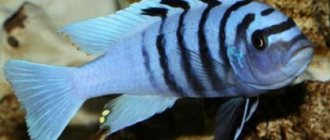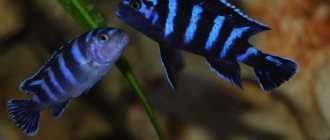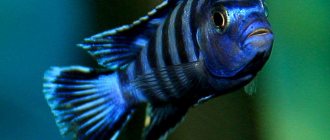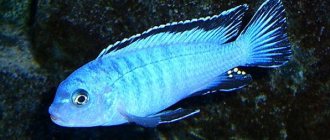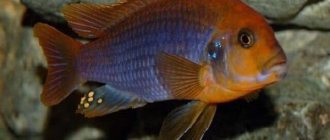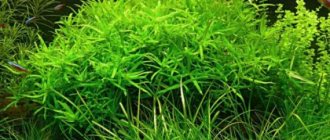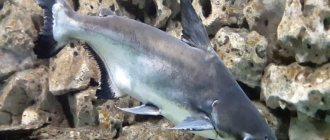Blue Aki, also known as Pseudotropheus spec. "Acei") is a popular aquarium fish from the African cichlid family, common in Lake Malawi. Sometimes there is another reading of the name of the fish - pseudotropheus akaei or akae.
The most popular morph is the one that gave the fish its name - a blue body with yellow fins, but this is far from the only morph. No less colorful are such morphs as aki itungi, ngara, msuli, luwala reef. These colors are not selective, it all depends on the habitat of the fish.
It should be noted that despite all its popularity, aquarists rarely come across this fish. The reason is that the period of color acquisition is too long (about six months). All this time, the flock of ackee looks very inconspicuous.
Blue Aki is a medium-sized fish; in the wild its size rarely exceeds 10 cm; in an aquarium it can grow up to 12-15 cm, and sometimes up to 18 cm (rarely). It is difficult to distinguish a male from a female in adolescence, since there are no characteristic differences. Males are slightly larger and brighter, especially during the spawning period. Sometimes you can understand who is who by observing the flock for a long time - the male will always be in charge, subdominants from time to time may try to challenge his primacy.
The lifespan of Pseudotropheus blue ackee is about 8 years.
Appearance
Pseudotropheus have a torpedo-shaped body and grow up to 9-12 cm. The head has large and fleshy lips, and teeth for scraping algae are located in the oral cavity. The dorsal fin extends from head to tail and is often edged. The anal fin is pointed, with several bright oval spots. The tail is single-lobed.
Pseudotropheus Aceus.
As for color, representatives of this group can be found in all the colors of the rainbow: red, blue, yellow, etc. Many species have different geographical races, which also differ in the color of their scales. The body necessarily has transverse stripes of varying degrees of severity.
Pseudotropheus aceus Luwala reef aki blue: contents, compatibility, photo-video review
Blue Aki, also known as Pseudotropheus spec. "Acei") is a popular aquarium fish from the African cichlid family, common in Lake Malawi.
Sometimes there is another reading of the name of the fish - pseudotropheus akaei or akae. The most popular morph is the one that gave the fish its name - a blue body with yellow fins, but this is far from the only morph. No less colorful are such morphs as aki itungi, ngara, msuli, luwala reef. These colors are not selective, it all depends on the habitat of the fish.
It should be noted that despite all its popularity, aquarists rarely come across this fish. The reason is that the period of color acquisition is too long (about six months). All this time, the flock of ackee looks very inconspicuous.
Blue Aki is a medium-sized fish; in the wild its size rarely exceeds 10 cm; in an aquarium it can grow up to 12-15 cm, and sometimes up to 18 cm (rarely). It is difficult to distinguish a male from a female in adolescence, since there are no characteristic differences. Males are slightly larger and brighter, especially during the spawning period. Sometimes you can understand who is who by observing the flock for a long time - the male will always be in charge, subdominants from time to time may try to challenge his primacy.
The lifespan of Pseudotropheus blue ackee is about 8 years.
Behavior and Compatibility
Belongs to representatives of the Mbuna cichlids, characterized by a sharp and aggressive disposition. However, unlike its closest relatives, it has a softer character and can get along with other calm fish species. Intraspecific relationships are based on competition between males. Each of them occupies a certain area of the aquarium and zealously protects it from rivals, engaging in small skirmishes. Females, in turn, swim peacefully throughout the entire space and can unite in groups. Thus, in a small aquarium there should be at least 3 females per one male Pseudotropheus Aki.
General information
Pseudotropheus sp. is a genus of freshwater ray-finned fish from the Cichlid family. Under natural conditions, they are endemic to Lake Malawi (Nyasa). They belong to the Mbuna group, which literally means “fish living in rocks.” It was not by chance that the fish received this name. They live along rocky shores, where they find shelter and their main food - algae, which they scrape off with the help of special teeth.
Pseudotropheus are medium-sized fish with a variety of colors and moderate aggressiveness, which makes them one of the most beloved cichlids by aquarists.
Stamp depicting pseudotropheus, 1998
The taxonomy of the genus is repeatedly revised and changes are made in accordance with the latest data, which only proves that the ichthyofauna of Lake Malawi has been poorly studied.
It is worth noting that many species of pseudotropheus are capable of interbreeding with each other, so the problem of maintaining a “clean line” in the aquarium hobby remains relevant.
Breeding/reproduction
In a home aquarium, the appearance of fry is quite possible. The method of reproduction is unique to cichlids from lakes Malawi and Tanganyika. During the mating season, the male chooses a flat stone in his territory. He cleans it out and begins to invite females to this makeshift nest. At this time, males become belligerent towards rivals and other fish, so it is advisable to carry out breeding in a separate tank with identical water conditions. When the female is ready, she accepts the male’s advances and one by one releases small portions of eggs, which after fertilization she immediately takes into her mouth. The entire incubation period (3–4 weeks) will take place in the root.
BLUE ZEBRA (Maylandia callainos)
FSB
2 192
Share
The blue zebra naturally lives among rocks in the northern part of Lake Nyasa (Malawi), located in Africa. The fish have attractive colors and interesting behavior. Recommended for keeping by trained aquarists.
Maylandia callainos has a bluish coloration. Low-contrast transverse dark stripes run across the entire body area. Males are much brighter colored than females. In addition, they are slightly larger, and their frontal part is more developed. The maximum size of fish is 13.5 cm.
It is recommended to keep blue zebras in a small group of 5-6 individuals. For such a number of fish, an aquarium with a volume of at least 150 liters is required. you need to keep in mind that these fish have an aggressive disposition, so keeping more than one male together is unacceptable. There should only be 1 male and several females in the aquarium. If the aquarium is large enough, then it is possible to keep cichlids of comparable size, representatives of Mbuna, together with blue zebras.
At the bottom of the aquarium you need to place stones of various sizes; it is advisable to install grottoes in the corners. Plants and driftwood in aquariums with these fish are completely unnecessary, so you can do without them. It is best to use coarse river sand or its mixture with gravel as a substrate.
Water parameters: temperature 24-28° C, hardness dH 8-25°, acidity pH 7.6-8.8. Filtration, aeration and weekly replacement of up to ½ of the aquarium water with fresh water are necessary.
Lighting is moderate, lasting 9-10 hours a day.
Zebra blue fish is herbivorous and in nature feeds on algae that grows on the surface of stones, as well as small aquatic insects that live on them. In an aquarium environment, fish will eat most of the foods offered, which should include predominantly plant-based foods, such as flakes containing spirulina, blanched spinach and lettuce. Live and frozen bloodworms and Artemia nauplii can be used as additional food. Feed the fish 1-2 times a day.
Reproduction
Under acceptable conditions, blue zebras can give birth.
To breed fish, 1 male and 3-4 females are placed in a separate aquarium, in which there are large flat stones at the bottom and there are many open places for spawning.
Spawning is stimulated by varied nutrition and maintaining water parameters in the following range: temperature 25-27° C, acidity pH 8.2-8.5.
The male selects a spawning site, which is usually the surface of a large flat stone, and cleans it of dirt and algae. Then he tries with all his appearance to attract a female to him
When one of the females shows attention to him, she swims up to the spawning site and spawns her eggs there, after fertilization by the male, the female collects all the eggs in her mouth, where the eggs are incubated for 3-4 weeks. At this time, the female does not eat anything and should not be disturbed, since if frightened she may swallow the eggs or spit them out
The hatched fry are large enough to feed on Artemia nauplii from the first days of their lives.
Tags blue zebra, maylandia callainos
Found an error or a dead link?
Select the problematic fragment with the mouse and press CTRL+ENTER. In the window that appears, describe the problem and send it to the resource Administration.
Maintenance and care
Conditions
Pseudotropheus aceus is quite easy to keep, especially for those who are not new to cichlids. Unlike other relatives, this fish prefers a gregarious lifestyle; it is better not to keep them alone or in pairs. The optimal option is a group of 7-10 individuals, respectively, the volume of the aquarium for them should be from 120-150 liters or more, and at least 200-300 liters if there are neighbors.
A powerful filter and constant aeration will be required, and a strong flow of water is undesirable. Water parameters are similar to those indicated for other species of the Cichlidae family. Temperature – 25-29°C, hardness – 10-20°dH, acidity – 6-8 pH. Water changes once a week are advisable.
The best option for soil would be coarse sand, but this is not essential. Lighting should be moderate. Plants are planted in the aquarium at will, the main thing is to choose species that can tolerate hard water (cryptocrine, anubias, hornwort, possibly Vallisneria).
It is advisable to install a certain amount of driftwood as decoration; shelter is not required or is possible at a minimum (for other types of fish). Atsey is one of the rare cichlids that is practically not interested in secluded corners, preferring to be among its fellows.
Habitat
Endemic to the African rift lake Malawi (another name for Nyasa), located in the east of the continent between the countries of Malawi, Mozambique and Tanzania.
It lives along the western coastline of the island, characterized by sandy and rocky substrates. Brief information:
- Aquarium volume - from 100 liters.
- Temperature - 24–28°C
- pH value – 7.6–8.8
- Water hardness - medium to high hardness (10–25 dGH)
- Substrate type - sand
- Lighting - moderate
- Brackish water - no
- Water movement - weak, moderate
- The size of the fish is 10–12 cm.
- Nutrition - any with herbal supplements
- Temperament - relatively peaceful
- Keeping in a harem with one male and several females
Feeding pseudotropheus
When keeping pseudotropheus at home, special attention must be paid to proper nutrition. We must not forget that more than 60% of the diet of these cichlids consists of plant foods. Long-term feeding of high-protein live or frozen food (bloodworms, tubifex, etc.) can lead to problems with the gastrointestinal tract and even death of the fish. And such food itself can become a source of infections.
Therefore, it is best to opt for high-quality dry food with a high algae content:
1. Tetra Malawi - food specially developed for Malawian cichlids of the Mbuna group. Available in the form of flakes and granules, 40% consists of algae (spirulina, nori, chlorella). Fully satisfies the nutritional needs of herbivorous cichlids.
2. Tetra Cichlid Algae Mini - food in the form of balls containing spirulina. It is highly palatable and fully provides melanochromis with all nutrients.
3. TetraPro Algae - chips prepared using modern low-temperature technology, which allows you to preserve even more useful vitamins. The green center of the food is a concentrate of spirulina algae.
Compatibility with other fish
Pseudotropheus Aki is considered one of the most peaceful species of cichlids, with which many types of fish can get along well. Almost any commensurate species can suit them as neighbors; they also get along well with aulonocara, copadichromis, and otopharynx
Nutrition
An omnivorous species that will accept most popular foods (dry, frozen, sinking) in a home aquarium. The main condition is that more than half of the diet should consist of products of plant origin. Accordingly, you cannot feed exclusively protein foods, for example, only bloodworms, brine shrimp, etc.
Our product Aqvium natural dry food for small and medium fish from clean lakes of Siberia and Northern Crimea in environmentally friendly biodegradable packaging.
Find out more
Fish diseases
The main cause of most diseases of Malawian cichlids is unsuitable housing conditions and poor-quality food, which often leads to a disease such as Malawi Bloat. If the first symptoms are detected, you should check the water parameters and the presence of high concentrations of hazardous substances (ammonia, nitrites, nitrates, etc.), if necessary, bring all indicators back to normal and only then begin treatment. Read more about symptoms and treatment methods in the section “Diseases of aquarium fish”.
ACARA PORTO ALEGRE: DESCRIPTION, PHOTO, CARE, BREEDING
BLUE DEMPSY: DESCRIPTION, CARE, PHOTO, FEEDING, CONTENTS
Cornflower blue haplochromis: DESCRIPTION, CONTENTS, BREEDING, COMPATIBILITY, PHOTO, VIDEO.
Rasbora maculata
Family: Carp-toothed.
Comfortable water temperature: 24-27 C.
Ph 5-6.8.
Behavior: Peaceful.
Compatibility: With all peaceful fish.
Habitat: Southeast Asia, Borneo, Singapore, Sumatra, Malay Peninsula.
Note: Biologists constantly revise nomenclature. Now there is confusion with zebrafish and rasboras. Therefore, cuneiform rasbora is no longer rasbora, but Trigonostigma. And rasbora “galaxy” is now generally Danio.
Rasbora maculata photo
This fish is also called the dwarf rasbora. The body of the rasbora maculata is elongated and long, the tail is thin. The main color is red-pink, fading to reddish-brown on the back. The abdomen is yellow shiny. There are about 5 dark spots scattered throughout the body. The fish is very small, only 2.5 cm.
Rasbora is a schooling fish. It can be kept in a small flock (6-7 individuals) in a 15-liter aquarium. The aquarium should be long, with plants. Rasbora maculata is very capricious. Instantly reacts to violations of detention conditions, lack of oxygen, dirty water and cannot tolerate temperature fluctuations. Susceptible to diseases.
Aeration and filtration are required. A weekly change of fresh water is recommended.
Rasbora maculata photo
The most important thing is that there are no excessive concentrations of nitrogen compounds and phosphates in the aquarium. This is the main problem for fish that beginners make. Ammonia, nitrite, nitrate, phosphates are the root cause of illness and death in pets. Every conscientious aquarist should always have a set of drop tests on hand, at least for nitrate and phosphate. Fortunately, they have now become inexpensive, there are no problems with their assortment and acquisition. For example, we can in good conscience recommend you the cool UHE drop tests that have been tested on ourselves, but they are only sold online. In stores in your city - offline, you can find inexpensive Vladox tests.
When changing water, it would be useful to use clean water supply and use preparations that neutralize harmful substances. For example, Tetra AquaSafe - it removes chlorine compounds, heavy metals + contains B vitamins, iodine and other aquarium goodies. Those. With it, you can safely pour water into the aquarium without fear of harming your beloved pets.
There are usually no problems with feeding rasbor. They eat almost any food. The only caveat is that the food for them should be small and slowly sinking. This is due to their small mouth and the fact that they prefer to take food from the surface or in the water column.
We recommend food from the Tetra MicroFood series, namely chips. In our opinion, this is the ideal food for these babies. The chips are small and sink very slowly into the water. Due to this, the fish have time to eat everything and fill their bellies to the top.
Rasbora maculata video +
Subscribe to our YouTube channel so you don't miss anything
Rasbora Brigitte
Rasbora measure
Rasbora cuneiformis
All about guppy
Microassembly galaxy Aquarium for beginners Predatory aquarium fish
